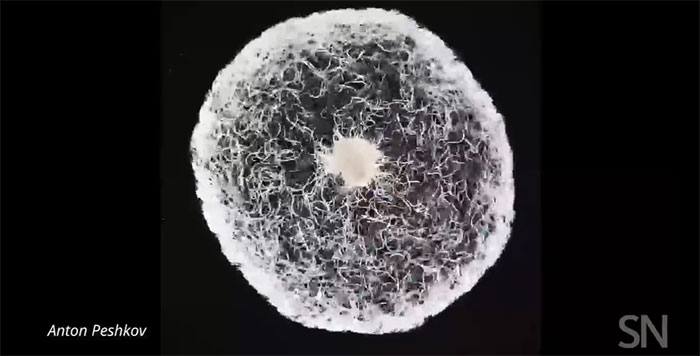The complicated way of moving thousands of vinegar worms in a drop of water
Observing the swarm of vinegar worms swimming under a microscope, the scientists discovered that they moved in complex synchronization.
Anton Peshkov, a physicist at the University of Rochester in New York, USA, and his colleagues observed thousands of fruit worms (Turbatrix aceti) swimming in a drop of water under a microscope to better understand how they move. Science on February 5 reported. The results of the study were published in the journal Soft Matter.
Fruit worms are animals only about 1 mm long, belonging to the nematode phylum. With more than 25,000 species scientifically described to date, roundworms are among the most prolific organisms on the planet. Many of these species are parasites. Others, such as Turbatrix aceti, feed on tiny microorganisms in many environments on Earth, including vials of vinegar. This gives them the name vinegar worms.
Anton Peshkov's research group is interested in fruitworms not because of where they live, but about how they move. Like many birds or fish, they move in synchronized groups.

Thousands of vinegar worms swim in a drop of water under a microscope.
After randomly moving through the drop for almost an hour, some of the worms began to gather in the center, while others swam to the edge, moving around the edge like cars around a roundabout. Not long after, each one began to curl its body, the others nearby also waved in the same way. Then the whole flock oscillates, moving in sync with a rhythm that only they perceive.
Peshkov marveled at the complexity and synchronicity of their movements. "This is a combination of two different types of synchronization. Motion and oscillation," he said.
The study also showed another surprising result. As the swarm swims in unison, they push against the edge of the drop, temporarily preventing the drop from shrinking as it slowly evaporates. When the team of experts measured the impact force of the fruit worms, they found that they were able to move objects hundreds of times their own weight.
- Eat poisoned banana vinegar?
- Birds suffer the best hardship: Flying thousands of miles, not eating or drinking
- 10 extreme household cleaning tips or vinegar
- Rain worms in Norway
- Turn mango by-products into delicious vinegar thanks to reflux fermentation
- Video: Drop the camera in hot water to spin boiled eggs
- Vinegar - natural anti-fat
- These are the worms that are making the whole world excited. The reason is ...
- Use a selfie to keep track of 'parasitic worms' moving back and forth on the face for 2 weeks
- Discovered 4 species of marine worms with metallic scales
- Cure stinging jellyfish
- The mystery of the worms 'living worms', though killed hundreds of times
 Animal 'suffering' after hibernation
Animal 'suffering' after hibernation Why do goats climb well?
Why do goats climb well? Scientists were surprised to see chimpanzees eating turtles
Scientists were surprised to see chimpanzees eating turtles Giant catfish died deadly due to drought in Thailand
Giant catfish died deadly due to drought in Thailand